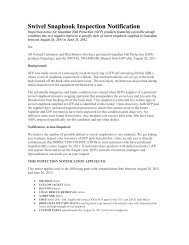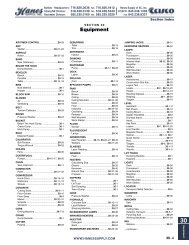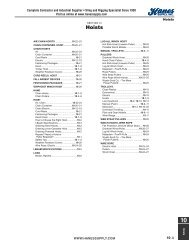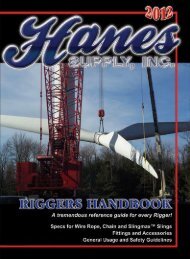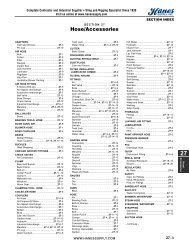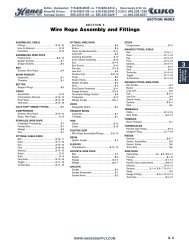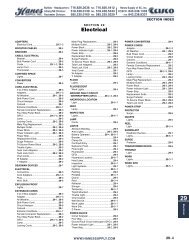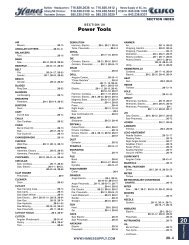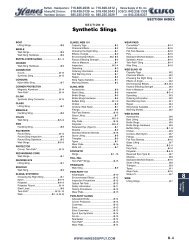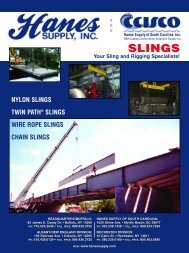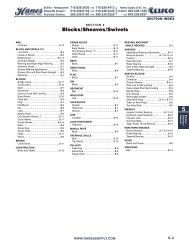22-Cutting Tools.40_200310.qxd - Hanes Supply, Inc
22-Cutting Tools.40_200310.qxd - Hanes Supply, Inc
22-Cutting Tools.40_200310.qxd - Hanes Supply, Inc
You also want an ePaper? Increase the reach of your titles
YUMPU automatically turns print PDFs into web optimized ePapers that Google loves.
<strong>22</strong><br />
<strong>Cutting</strong><br />
Tools<br />
<strong>Cutting</strong> Tools<br />
Complete Contractor and Industrial Supplier • Sling and Rigging Specialist Since 1930<br />
Visit us online at www.hanessupply.com<br />
band Saw blade Characteristics<br />
There are hundreds of band saw machine models in use today and tens of<br />
thousands of potential band saw blade specifications. Yet for each application,<br />
there is one “best” blade. Each of the following variables must be<br />
considered in selecting that best band saw blade specification for a given<br />
application.<br />
LENGTH - Band saw length varies by machine model. Blades are available<br />
custom welded to fit specific machines or in coil form for distributor or<br />
user welding. Blade length may be specified in either inches (e.g. 150") or<br />
in feet (e.g. 12'6"). Morse uses the foot designation.<br />
WIDTH - Most machines accept one width only. The following should be<br />
considered for machines that can accommodate multiple widths.<br />
• Wider blades allow more tension and more feed pressure for faster and<br />
straighter cuts in production applications.<br />
• In contour sawing on vertical machines, the smaller the radius in a given<br />
pattern, the narrower the blade required.<br />
TOOTH PITCH - Pitch determines the number of teeth per inch for a given<br />
cross section to be cut. More teeth per inch are needed for thin materials<br />
and fewer teeth per inch for thicker materials. Ideally, 6-10 teeth should be<br />
in contact with the work in metal cutting, while more teeth may be required<br />
for harder materials or a smoother finish. There should never be fewer than<br />
three teeth in contact with the work for bi-metal and six teeth for carbon.<br />
• Standard Pitch - A single, constant size and shape throughout the<br />
length of the blade or coil.<br />
M.K. Morse ®<br />
TOOTH FOrM:<br />
• Straight - A straight (0 O ) tooth face for metals with easy to<br />
moderate machinability or for applications with varying tooth<br />
loads such as pipe and structural materials.<br />
• Positive rake - Teeth “lean” into the work via a 5 to 10 O<br />
rake angle, for more aggressive cutting in moderate to<br />
difficult to machine materials.<br />
TOOTH TYPE:<br />
• Standard - Available in carbon and bi-metal, it features a 0 O rake angle<br />
and constant tooth pitch for general purpose sawing in a wide range of<br />
applications.<br />
• variable Pitch - Available in bi-metal only. Standard variable pitch<br />
features a 0 O rake angle with varying tooth and gullet sizes for smooth<br />
and more efficient cutting in both solid and structural materials.<br />
• variable Pitch - Positive rake - Available in bi-metal only, these blades<br />
offer a 10 O positive rake angle for faster, more aggressive cutting in<br />
thicker, harder to machine materials.<br />
• Skip - Available in carbon only. Wide, flat, shallow gullets for efficient chip<br />
removal in large sections of non-ferrous metals or non-metallic materials.<br />
• variable Pitch - Tooth and gullet size vary in progressive intervals<br />
through the length of the blade or coil. Varying tooth size reduces vibration<br />
for quieter, more efficient cutting.<br />
• Hook - Available in carbon and bi-metal. 10 O positive rake angle and<br />
rounded gullets allow for faster, more aggressive cutting with less feed<br />
pressure than straight face blades in both hard to cut metals and wood.<br />
band Saw blade Characteristics<br />
TOOTH SET - The teeth of most saw blades are offset<br />
to each side so that the cut or “kerf” is wider than<br />
the blade body. The set prevents the back of the<br />
blade from binding in the work.<br />
• raker - Available in both carbon and bi-metal<br />
and used for most standard, skip, and hook form<br />
specifications. Teeth are set in a recurring pattern -<br />
right, left, straight - with the straight tooth clearing or<br />
“raking” the chips from the work.<br />
• Wavy - Available in finer carbon and bi-metal tooth<br />
specifications. Teeth are set in a “wave” pattern<br />
reducing impact on individual teeth and increasing<br />
contact area with the work. The wave pattern allows<br />
better finish and reduces the risk of tooth damage<br />
in thin walled materials.<br />
• Alternate (ETS) - Used primarily in carbon specialty<br />
furniture blades, all teeth are set alternately to the<br />
left and right. Each tooth cuts resulting in faster,<br />
smoother cutting in wood and select non-ferrous<br />
alloy and non-metallic applications.<br />
• Modified raker -The primary set pattern used in<br />
bi-metal variable pitch blades. Unlike the standard<br />
raker design, where every third tooth “rakes”, modified<br />
raker features a straight or “raker” tooth only<br />
after 4 or 6 set teeth.<br />
variables Affecting blade Selection<br />
Variable Options Blade Choice Considerations<br />
Machine Blade Length Determined by Model Larger Machines - More capacity (larger pieces), more<br />
Size (300+ Options) control, higher production. Small machines - low cost.<br />
Blade Width(s) 1 - 8 Widths per Model Wide blades - more tension, feed pressure for for faster,<br />
straighter cut-off. Narrow widths - allow tight curved cuts<br />
or vertical machine.<br />
Frequency Production <strong>Cutting</strong> Bi-Metal Matrix or M42 Bi-Metal allows higher cutting speed, more feed pressure for<br />
of use in Metal faster cutting, greater resistance to wear & lower cost per cut.<br />
Production <strong>Cutting</strong> Carbon Hard Edge HEF, HB blades can withstand high production rates due to low<br />
in Wood Flexible Back of heat generation in wood.<br />
Hard Edge Hard Back<br />
Occasional Use/ Carbon Hard Edge Differing materials & applications subject blades to conditions<br />
Various Apps. Flexible Back or Hard which can destroy carbon or bi-metal blades. <strong>Cutting</strong> rates are<br />
(Maintenance in Edge Hard Back not critical. Okay to run carbon blades at lower speeds.<br />
Wood or Metal)<br />
Type of Easy to Cut Materials Carbon Hard Edge Low blade cost; high cost per cut.<br />
Materials Easier Manageability Flex Back or Hard Low blade cost; better performance on larger machines.<br />
Edge Hard Back or Higher blade cost; lower cost per cut.<br />
Bi-Metal Matrix<br />
Hard to Machine Bi-Metal M42 Only Bi-Metal blades offer heat resistance & wear resistance<br />
Metals (i.e. Stainless,<br />
Capable of cutting materials of moderate to difficult<br />
Special Alloys, etc.)<br />
machinability.<br />
Wood or Easy to Carbon hard Edge Can achieve good cost per cut due to easy cutting.<br />
Cut Material Flexible Back or Hard<br />
Hard Edge Hard Back<br />
Dimensions/ Various Dimensions Min. 3 Teeth in contact Ideal is 6-10 teeth in contact w/work. Use finer pitch for<br />
Shapes of of Solids w/work at all times harder materials. Too few teeth per inch can destroy teeth.<br />
Material Interrupted Cuts Determine TPI by Wall For production sawing in interrupted, irregular shapes use<br />
Pipe, Angle, Thickness rather than Variable Pitch tooth pattern if possible.<br />
I-Beam, etc.) nominal pipe or angle size.<br />
Finish Fine Finish Fine Pitch (More TPI) Fine finish from fine pitch will slow production rate.<br />
Rough Finish Coarse Pitch Faster cutting but rougher cut.<br />
Speed Fast <strong>Cutting</strong> Coarse Pitch Rough Cuts.<br />
of Cut Slow <strong>Cutting</strong> Fine Pitch Slow cutting will also help to prevent dulling of carbon blades<br />
in some harder materials.<br />
<strong>22</strong>-42<br />
WWW.HANESSUPPLY.COM



